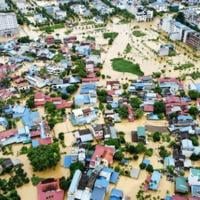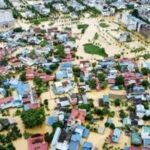Severe devastation hit Southeast Asia as Typhoon Yagi wreaked havoc, leaving millions affected by flooded homes, power outages, and damaged infrastructure. The death toll has surpassed 200.
In Vietnam, the number of fatalities reached 197, with eight confirmed deaths in northern Thailand, where one district is facing its worst floods in 80 years.
The typhoon made landfall in Vietnam over the weekend, causing massive rainfall that flooded areas in northern Vietnam, Laos, Thailand, and Myanmar, leading to deadly landslides and widespread river floods.
A farmer shared with AFP that his entire peach blossom plantation was submerged, destroying all 400 trees, resulting in an estimated loss of up to $40,000 for the season.
The high waters have destroyed more than 250,000 hectares of crops and livestock in Vietnam, especially affecting farmland around Hanoi. Thousands have been evacuated, and some are dealing with power cuts, with more than 15,000 people affected in a heavily hit district near Hanoi.
In Laos, a landslide in Lao Cai province resulted in seven deaths and 11 missing persons, with another village being wiped out, killing at least 34 and leaving 46 missing.
The Mekong River Commission issued a flood warning for Luang Prabang in Laos. In Thailand, the death toll rose to eight, with Mae Sai district facing its worst floods in 80 years. Relief efforts are ongoing, with the government mobilizing the military for assistance.
Myanmar is also experiencing severe flooding, particularly around the capital Naypyidaw. The impacts of climate change are exacerbating these extreme weather events, making destructive floods more common in the region.
Climate change is causing typhoons to intensify faster and last longer over land, as observed in recent years.





